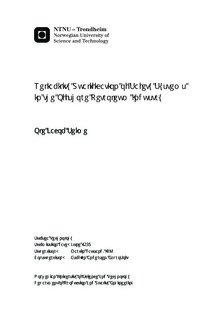| dc.contributor.advisor | Rausand, Marvin | nb_NO |
| dc.contributor.advisor | Andersen, Asbjørn | nb_NO |
| dc.contributor.author | Seime, Ole Jacob | nb_NO |
| dc.date.accessioned | 2014-12-19T12:21:05Z | |
| dc.date.available | 2014-12-19T12:21:05Z | |
| dc.date.created | 2013-09-16 | nb_NO |
| dc.date.issued | 2013 | nb_NO |
| dc.identifier | 648677 | nb_NO |
| dc.identifier | ntnudaim:10094 | nb_NO |
| dc.identifier.uri | http://hdl.handle.net/11250/240903 | |
| dc.description.abstract | This master thesis starts off by providing basic knowledge about relevant well type, well equipment, gas lift and well barriers. This is basic knowledge which is needed to understand the systems investigated throughout the rest of the thesis. Four annulus barrier configurations are found for gas lift systems. Their maintenance strategies are briefly described and general advantages and disadvantages are listed. Well barrier diagrams and well barrier schematics are alsoprovided for each configuration.The terms safety instrumented systemand safety instrumented function are briefly explained. Governing regulations regarding barriers are provided both forNorway and for theUnited Statesof America. Requirements regarding safety instrumented system and annulus well barriers in Norway follow. These include requirements for documentation.The safety analysis report (SAR) process is described both for non-proven and proven technology. This process and the included documentation vary for whether the components are certified as proven in use or prior use. The required documentation is also dependent on the system complexity. Relevant terms are discussed. Flowcharts for the various SAR processes are made for both non-proven and proven technology based on the OLF 070 guideline. Two case studies are used to describe the SAR process and to compare the process for non-proven versus proven technology. Some challenges when performing SAR are found and discussed. Potential improvements to the OLF 070 guideline and to IEC standards are also proposed. Probability of unavailability (PFD) calculations are provided for each of the gas lift configuration options based on the well barrier schematics and the well barrier diagrams. The results are discussed and an overall assessment of these configurations is made. The result shows that three of the options can be recommended. The option with three barrier elements has slightly better reliability than the most used gas lift configuration which only includes two barriers. Asystem weakness is reviled and an improvement proposed. The suggested improvement proves increased system reliability which resulted in recommendation of all four configurations options. A specified configuration is recommended not to be used. However, the suggested improvement may not be used in practise due to blocking of monitoring. Another improvement is suggested and analysed, but showed minor changes. | nb_NO |
| dc.language | eng | nb_NO |
| dc.publisher | Institutt for produksjons- og kvalitetsteknikk | nb_NO |
| dc.title | Reliability Qualification of Safety Systems in the Offshore Petroleum Industry | nb_NO |
| dc.type | Master thesis | nb_NO |
| dc.source.pagenumber | 147 | nb_NO |
| dc.contributor.department | Norges teknisk-naturvitenskapelige universitet, Fakultet for ingeniørvitenskap og teknologi, Institutt for produksjons- og kvalitetsteknikk | nb_NO |

